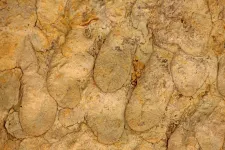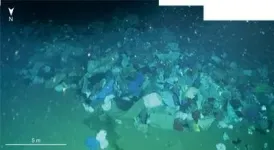Ions in molten salts can go 'against the flow'
2021-01-27
(Press-News.org) In a new article published in the scientific journal Communications Chemistry, a research group at Uppsala University show, using computer simulations, that ions do not always behave as expected. In their research on molten salts, they were able to see that, in some cases, the ions in the salt mixture they were studying affect one another so much that they may even move in the "wrong" direction - that is, towards an electrode with the same charge.
Research on the next-generation batteries is under way in numerous academic disciplines. Researchers at the Department of Cell and Molecular Biology, Uppsala University have developed and studied a model for alkali halides, of which ordinary table salt (sodium chloride) is the best-known example. If these substances are heated to several hundred degrees Celsius, they become electrically conductive liquids known as "molten salts". Molten salts are already used in energy contexts: for concentrated solar power in the Sahara desert and as electrolytes in molten-salt batteries that can be used for large-scale storage of electricity.
Despite their wide-spread use, some of the molten salt's basic properties are not yet fully understood. When it comes to batteries, optimising conductivity is a frequent goal. To produce a battery that is as efficient as possible, knowing what happens to individual ions is vital. This is what the Uppsala researchers are now investigating with their simulations.
"In the long run, the purpose of this research is to develop physical models for biological molecules. But these salts are relatively simple and make a good test bed," says Professor David van der Spoel, the group leader for the modelling project.
However, the researchers' simulations show that the salts are not as simple as they may seem at the first glance, and that they have some interesting properties, especially if various alkali halides are mixed together.
In a simplified theory, ions that move in an electric field (for example in a battery) do not interact with each other and are affected solely by the electric field. In their newly published study, the researchers were able to demonstrate that this is not always true. The study shows how, in a mixture of lithium ions with ions of fluoride, chloride and iodide, the lighter anions, fluoride and chloride, move towards the negative cathode along with the lithium ions in a (simulated) battery electrolyte.
"The negative ions are attracted both by the lithium ions and by the positive anode, and the net effect of these forces makes the lighter anions move slowly towards the cathode, since the positive lithium ions are also moving in that direction," says the first author of the study, Marie-Madeleine Walz.
In their continued research, the group will develop a water model to study the interaction of water molecules with ions. Their investigation will include, for example, how the properties of ions are affected by an electric field when there is water in the mixture.
INFORMATION:
ELSE PRESS RELEASES FROM THIS DATE:
2021-01-27
Researchers at the Francis Crick Institute, the UCL Cancer Institute, and the Cancer Research UK Lung Cancer Centre of Excellence have identified genetic changes in tumours which could be used to predict if immunotherapy drugs would be effective in individual patients.
Immunotherapies have led to huge progress treating certain types of cancer, but only a subset of patients respond, and hence a challenge for doctors and researchers is understanding why they work in some people and not others, and predicting who will respond well to treatment.
In their paper, published in Cell today (27 January), the scientists looked for genetic and gene expression changes in tumours in over 1,000 patients being treated with checkpoint inhibitors, a type of immunotherapy which stops cancer cells ...
2021-01-27
Health authorities should develop targeted health messages for vaping product and e-liquid packaging to encourage smokers to switch from cigarettes to e-cigarettes and to prevent non-smokers from taking up vaping, a researcher at the University of Otago, Wellington, New Zealand says.
Professor Janet Hoek, a Co-Director of the University's ASPIRE 2025 Research Centre has led new research analysing the impact of on-package messaging on e-liquids.
The research team found messages presenting electronic nicotine delivery systems as a lower risk alternative to smoking could encourage about a third of smokers to trial them. On the other hand, messages about the ...
2021-01-27
As Covid-19 continues to put pressure on healthcare providers around the world, engineers at the University of Bath have published a mathematical model that could help clinicians to safely allow two people to share a single ventilator.
Members of Bath's Centre for Therapeutic Innovation and Centre for Power Transmission and Motion Control have published a first-of-its-kind research paper on dual-patient ventilation (DPV), following work which began during the first wave of the virus in March 2020.
Professor Richie Gill, Co-Vice Chair of the Centre ...
2021-01-27
Scientists have calculated the mass range for Dark Matter - and it's tighter than the science world thought.
Their findings - due to be published in Physics Letters B in March - radically narrow the range of potential masses for Dark Matter particles, and help to focus the search for future Dark Matter-hunters. The University of Sussex researchers used the established fact that gravity acts on Dark Matter just as it acts on the visible universe to work out the lower and upper limits of Dark Matter's mass.
The results show that Dark Matter cannot be either 'ultra-light' or 'super-heavy', as some have theorised, unless an as-yet undiscovered force also acts upon it.
The team used the assumption that the only force acting on Dark Matter is gravity, ...
2021-01-27
Although the reputation of Champagne is well established, the history of Champagne wines and vineyards is poorly documented. However, a research team led by scientists from the CNRS and the Université de Montpellier at the Institut des sciences de l'évolution de Montpellier* has just lifted the veil on this history by analysing the archaeological grape seeds from excavations carried out in Troyes and Reims. Dated to between the 1st and 15th centuries AD, the seeds shed light on the evolution of Champagne wine growing, prior to the invention of the famous Champagne, for the first time. According to the researchers, "wild"** ...
2021-01-27
Even after accounting for differences in income, education, caregiver support, special education services and parental reports of misbehavior and family conflict, elementary school-age Black children are 3.5 times more likely to be suspended or placed in detention than their white peers, a new study finds.
The results were unsettling even to the researchers themselves, who were familiar with previous research into racial disparities in school discipline. Previous studies primarily used school records, but this study was able to use a nationwide self-reported dataset, with data collected as part of a long-term investigation into how the ...
2021-01-27
A newly discovered trace fossil of an ancient burrow has been named after University of Alberta paleontologist Murray Gingras. The fossil, discovered by a former graduate student, has an important role to play in gauging how salty ancient bodies of water were, putting together a clearer picture of our planet's past.
"One could not find a more passionate and influential teacher of science in the classroom, in the field or at a conference," said Ryan King, lead author of the study and now an adjunct professor at Western Colorado University.
"Naming the fossil after Gingras was a straightforward decision since his research focuses ...
2021-01-27
Boulder, Colo., USA: Benthic plastic litter is a main source of pollutants in oceans, but how it disperses is largely unknown. This study by Guangfa Zhong and Xiaotong Peng, published today in Geology, presents novel findings on the distribution patterns and dispersion mechanisms of deep-sea plastic waste in a submarined canyon located in the northwestern South China Sea.
Evidence collected from a series of manned submersible dives indicate that the plastic litter items transported and deposited in the canyon are most likely controlled by turbidity currents. Here the plastic litter items are highly heterogeneously distributed: Up to 89% of them occur in a few scours of the canyon.
The plastic items are mostly accumulated in longitudinal litter piles of 2-61 m long, 0.5-8 m wide, ...
2021-01-27
JANUARY 26, 2021, NEW YORK - A study led by Ludwig Chicago Co-director Ralph Weichselbaum and Yang-Xin Fu of the University of Texas Southwestern Medical Center has shown how bacteria in the gut can dull the efficacy of radiotherapy, a treatment received by about half of all cancer patients. Their findings appear in the current issue of the Journal of Experimental Medicine.
"Our study identifies two families of gut bacteria that interfere with radiotherapy in mice and describes the mechanism by which a metabolite they produce--a short chain fatty acid called butyrate--undermines the therapy," said Weichselbaum.
A wide variety of commensal bacteria inhabit ...
2021-01-27
Birds play an underrecognized role in spreading tickborne disease due to their capacity for long-distance travel and tendency to split their time in different parts of the world - patterns that are shifting due to climate change. Knowing which bird species are able to infect ticks with pathogens can help scientists predict where tickborne diseases might emerge and pose a health risk to people.
A new study published in the journal Global Ecology and Biogeography used machine learning to identify bird species with the potential to transmit the Lyme disease bacterium (Borrelia burgdorferi) to feeding ticks. The team developed a model that identified birds known to spread Lyme disease with 80% accuracy and flagged 21 new species that should be prioritized for surveillance.
Lead author Daniel ...
LAST 30 PRESS RELEASES:
[Press-News.org] Ions in molten salts can go 'against the flow'






